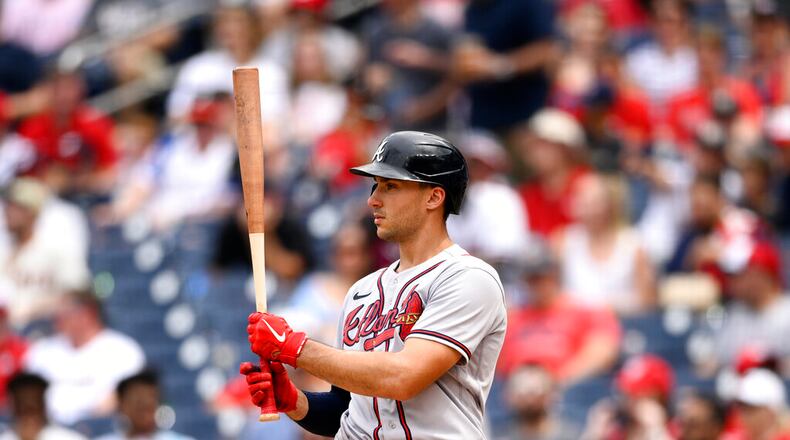SEATTLE – Baseball is like any other industry. On a given day, a story – or a few – might catch everyone’s attention.
This was the case Friday, when Major League Baseball announced new rule changes for the 2023 season, as approved by a majority vote from the joint Competition Committee.
The pitch clock will debut in the majors next season. In addition, the league is restricting defensive shifts and adding larger bases.
Here is what the Braves had to say about each change.
Pitch clock – good or bad?
The basic rule here: A pitcher must begin his motion before the expiration of the timer. Pitchers will have 15 seconds between pitches when the bases are empty, and 20 when there is at least one runner on base. It has been tested in the minor leagues.
“I’m not necessarily a fan of it, to be honest with you,” reliever Kriby Yates said. “For me, they keep comparing the big-league game to the minor-league game, and I think they’re completely different. I understand minor-league games are quicker. I’m sure the pitch clock helps that, but I don’t think that’s a fair comparison because in the big leagues, everybody’s playing for something. In the minor leagues, some organizations play to win and some don’t – it’s a lot more about development down in the minor leagues than it is about winning a baseball game.”
“Talking with some guys in Triple A, they say they love it,” third baseman Austin Riley said. “Guys are for it. They’re for it and it makes the game quicker. We play some long games. … I’m for (speeding up the game). … ”I know it’s going to bother some pitchers – and some hitters that have their routines. It’s all an adjustment. But I think it’s probably for the good of the game.”
The catch is this: Pitchers will be assessed a ball if they violate the rule, hitters a strike.
According to an MLB release, a pitcher may step off the rubber to reset the timer twice per plate appearance without a penalty. Doing so more than twice results in a balk.
A hitter must be in the batter’s box and ready to swing with at least eight seconds remaining. Hitters receive one timeout per plate appearance.
“I experienced it when I was in Triple A,” said Braves manager Brian Snitker, a longtime minor-league skipper. “The clock works. I think guys like it, honestly, once they get over the nuance of it and everything.”
Minor-league testing included pitchers having to throw a pitch in 14 seconds with the bases empty. Braves starting pitcher Kyle Wright felt this was too short, so luckily MLB added one second. Wright agrees with the pitch clock’s implementation.
“I think there’s a lot of times in games when we as players take too long for kind of an unnecessary reason,” Wright said. “Sometimes the game dictates that, which I understand – whether it’s an at-bat, a pitch. But a lot of times, our game moves too slow.”
In Triple A, the pitch clock has reduced the average time of a nine-inning game by 26 minutes from last season, according to MLB. Stolen-base attempts have increased, as has the success rate on them. In its most recent week of games, minor-league contests have averaged 0.45 pitch-clock violations per game.
First baseman Matt Olson said he believes most hitters are OK with the pitch clock. He understands pitchers may not like it.
“Especially the way that pitching has trended, to where it’s, take your time, throw a max-effort pitch, get the ball back, take your time again, throw a max-effort pitch,” Olson said. “I wonder if that will lead to more in the zone (pitching), guys having to keep tempo and rhythm. I wonder if it’s going to change that max-effort type of reliever who comes in or whatever it may be.”
Added Yates: “I think it’s one of those things that it has to play out to see what it’s really ultimately going to be. You never know, maybe it’s not that different and it is a smooth transition. I really think a big-league game, when you’ve got runners on and the game starts speeding up on you, if you need to take extra time, I think that’s where it’s going to be a little different. MLB’s made it pretty apparent they want more offense in the game. You get pitchers out of rhythm, that might create more offense.”
Veteran pitchers, like Kenley Jansen, may not appreciate the move to a pitch clock. For hitters, it simply means they must get in the box quicker. That’s not a bad thing for Olson, who said he likes to keep at-bats moving. Outfielder Michael Harris II likes to base his time in and out of the box on how fast the pitcher is working.
“It might cause a little conflict,” Harris said of the timer, “but it might take a little extra time to get used to.”
How MLB is restricting shifts
“Ban the shift!”
You have probably heard cries for this throughout corners of baseball’s fanbase. Well, it happened. The shift technically is not banned, but it will change a lot.
“Obviously it’s been so long since I haven’t been shifted,” said Olson, a left-handed hitter. “It’s going to be kind of weird. It’ll be weird to have the four-hole open again.”
The rules are this: Teams must have two infielders positioned on each side of second base when a pitch is thrown. All four infielders must have both feet “within the outer boundary of the infield when the pitcher is on the rubber,” according to the league. Infielders may not switch sides unless there is a substitution. Teams can shift, but any adjustments they make must be within those parameters.
If you like seeing Riley in right field, enjoy it for the rest of this season, because it is going away.
“The guy in right field – like, me going all the way to the right-field grass – I was never for, just because I like to keep the game, the game,” Riley said. “My thing is I don’t care how many people are on one side of the field, as long as you’re in the dirt.”
The left-handed hitting Harris does not play in the infield, but he has an opinion as a hitter. You might be surprised at it.
“I don’t really have a problem with them shifting because I can tend to change my approach based on how they’re shifting,” Harris said. “If they shift (pull-side), I go even more toward the third-base line and I take my hit then. I’d rather they shift, honestly, because if they’re playing straight up, more than likely I’m getting out every time I hit a ground ball in the infield.”
Here’s an interesting point: The new rules could create more highlights. Someone like shortstop Dansby Swanson might make even crazier plays because he will be playing closer to his actual position in the future.
“He’s going to be able to show it off a little better,” Olson said. “I think we’ll probably end up seeing some more really good plays because of it, whereas the shift kind of limits everybody’s range.”
“Really, you’ve got to have guys that can have some range and can play the position like it’s essentially supposed to be played,” Riley said.
These shift restrictions will take baseball to a more traditional form.
“I know you can sit there and say (to left-handed hitters being shifted), ‘Just hit the ball to third base,’ but guys pitch to you knowing the way the defense is set up, so the last thing they want to do is give you a pitch to go over there,” Olson said. “I think it’ll be good. I think it’s good for not only hitting, but I think it’s good for displaying guys’ range on defense.”
What can bigger bases do?
The size of first, second and third base will increase from 15 inches square to 18 inches square. MLB expects this to improve player safety.
“I think it’s good so guys don’t get stepped on at first base or whatever,” Olson said.
But any effect on the game itself?
“The only thing baseball-wise that I can think of,” Olson said, “is maybe a guy getting to the bag that split-second earlier.”
“If you barrel a ball down the line, you might catch a bag if you have a couple more inches,” Riley said. “It’s just for safety purposes, and I have no problem with that. You never want to see a guy get hurt or a guy get run into.”
About the Author
Keep Reading
The Latest
Featured



